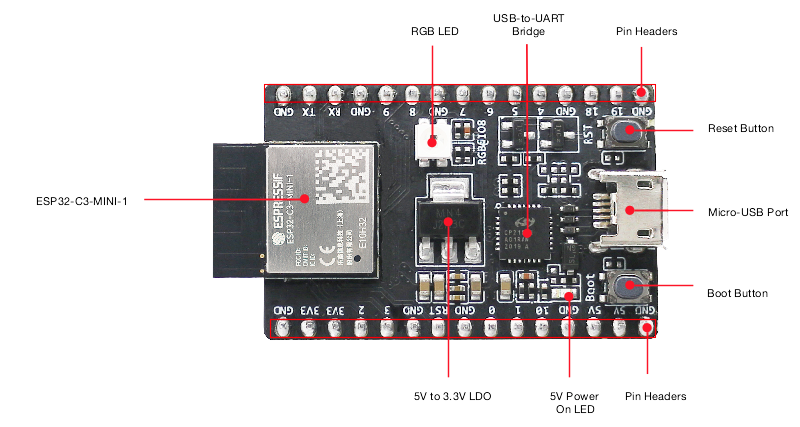Support for generic ESP32-C3 boards. More...
Detailed Description
Support for generic ESP32-C3 boards.
ESP32-C3-DevKit
Table of Contents
Overview
The Espressif ESP32-C3-DevKit boards are a couple of boards that use one of the following modules:
- ESP32-C3-MINI-1x module (ESP32-C3-DevKitM-1 board)
- ESP32-C3-WROOM-02x module (ESP32-C3-DevKitC-02 board)
Since the number of GPIOs and their possible uses on the ESP32-C3 are quite limited, the ESP32-C3-DevKit should also work for most other ESP32-C3 boards. Any modifications required for specific applications could be overridden by application-specific board configuration.

Hardware
This section describes
- the MCU,
- the default board configuration,
- optional hardware configurations,
- the board pinout.
MCU
Most features of the board are provided by the ESP32-C3 SoC. For detailed information about the ESP32-C3 variant (family) and ESP32x SoCs, see section ESP32 SoC Series.
Board Configuration
ESP32-C3-DevKit boards have no special hardware on board with the exception of a single pin RGB-LED.
All GPIOs are simply broken out for flexibility. Therefore, the board configuration is the most flexible one which provides:
- 6 x ADC channels at maximum
- 1 x SPI
- 1 x I2C
- 1 x UART
- 2 x PWM with 2 channels each
- 1 RGB-LED
Since all GPIOs have broken out, GPIOs can be used for different purposes in different applications. For flexibility, GPIOs can be listed in multiple peripheral configurations, but they can only be used for one peripheral at a time. For example, GPIO4 is used in the ADC channel definition, the PWM channel definition and the definition of the SCL signal for I2C_DEV(0).
This is possible because GPIOs are only used for a specific peripheral interface when either
- the corresponding peripheral module is used, e.g.
periph_i2candperiph_spi, or - the corresponding init function is called, e.g.
adc_initandpwm_init.
That is, the purpose for which a GPIO is used depends on which module or function is used first.
For example, if module periph_i2c is not used, the GPIOs listed in I2C configuration can be used for the other purposes, that is, GPIO4 can be used as ADC channel or PWM channel.
The following table shows the default board configuration, which is sorted according to the defined functionality of GPIOs. This configuration can be overridden by application-specific configurations.
| Function | GPIOs | Remarks | Configuration |
|---|---|---|---|
| BUTTON0 | GPIO9 | ||
| ADC | GPIO0, GPIO1, GPIO2, GPIO3, GPIO4, GPIO5 | ADC Channels | |
| PWM_DEV(0) | GPIO3, GPIO4 | PWM Channels | |
| PWM_DEV(1) | GPIO10, GPIO7 | conflicts with SPI_DEV(0) | PWM Channels |
| I2C_DEV(0):SCL | GPIO4 | I2C Interfaces | |
| I2C_DEV(0):SDA | GPIO5 | I2C Interfaces | |
| RGB-LED | GPIO8 | supported by driver module ws281x | |
| SPI_DEV(0):CLK | GPIO6 | SPI2_HOST (FSPI) is used | SPI Interfaces |
| SPI_DEV(0):MISO | GPIO2 | SPI2_HOST (FSPI) is used | SPI Interfaces |
| SPI_DEV(0):MOSI | GPIO7 | SPI2_HOST (FSPI) is used | SPI Interfaces |
| SPI_DEV(0):CS0 | GPIO10 | SPI2_HOST (FSPI) is used | SPI Interfaces |
| UART_DEV(0):TxD | GPIO21 | Console (configuration is fixed) | UART interfaces |
| UART_DEV(0):RxD | GPIO20 | Console (configuration is fixed) | UART interfaces |
- Note
- The configuration of ADC channels contains all ESP32-C3 GPIOs that could be used as ADC channels.
- PWM_DEV(1) is only available if SPI_DEV(0) is not used.
For detailed information about the peripheral configurations of ESP32-C3 boards, see section Common Peripherals.
Board Pinout
The following figures show the pinouts as configured by default board definition.


The corresponding board schematics can be found:
Flashing the Device
Flashing RIOT is quite easy. The board has a Micro-USB connector with reset/boot/flash logic. Just connect the board to your host computer and type using the programming port:
For detailed information about ESP32-C3 as well as configuring and compiling RIOT for ESP32-C3 boards, see RIOT-OS on ESP32 SoC Series Boards.
Files | |
| file | arduino_iomap.h |
| Mapping from MCU pins to Arduino pins. | |
| file | board.h |
| Board definitions for ESP32-C3-DevKit boards. | |
| file | gpio_params.h |
| Board specific configuration of direct mapped GPIOs. | |
| file | periph_conf.h |
| Peripheral configurations for ESP32-C3-DevKit boards. | |